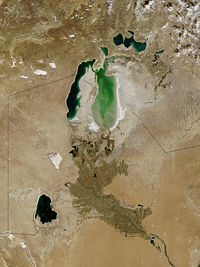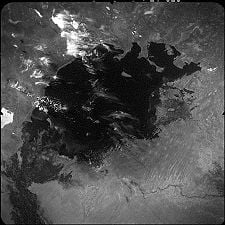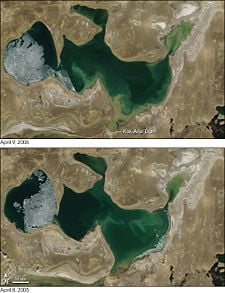Aral Sea
| Aral Sea | |
|---|---|
| | |
| Location | Kazakhstan, Uzbekistan (Central Asia) |
| Coordinates | |
| Lake type | endorheic |
| Primary sources | Amu Darya, Syr Darya |
| Basin countries | Kazakhstan, Uzbekistan, Turkmenistan, Tajikistan, Afghanistan |
| Surface area | 17,160 km² (2004), 28,687 km² (1998), 68,000 km² (1960) |
| Settlements | (Aral) |
The Aral Sea (Kazakh: Арал Теңізі, Aral Tengizi, Uzbek: Orol dengizi, Russian: Аральскοе мοре) a landlocked endorheic sea in Central Asia, straddles the boundary between Uzbekistan to the south and west and Kazakhstan to the north and east. The name roughly translates as "Sea of Islands," referring to more than 1,000 islands of 2.5 acres (one hectare) or more that dotted its waters.
Once the fourth-largest lake on Earth, the Aral Sea shrank to less than 50 percent its original size in a matter of decades. This reduction came as a result of the diversion of its in-flowing rivers, the Syr Darya and the Amu Darya, by the Soviet Union for irrigation purposes. This loss of water turned the once freshwater lake into one as salty as the ocean. By the end of the twentieth century, the once great sea had been broken into two separate lakes.
Its entire ecosystem suffered a near collapse due not only to diversion practices, but also to extreme pollution resulting from biological weapons testing during the Cold War, industrial projects, and fertilizer runoff. The health and livelihoods of thousands of people living in its ecosystem were severely comprised.
Since the collapse of the Soviet Union, nations and organization began coming to the aid of the Kazakh and Uzbeki governments in an attempt to reverse the wrongs that had been done to the Sea and its rivers. As a result, the North Aral is reviving. However, the Uzbeki government is focusing on oil exploration in the South Aral's dry seabed, rather than reviving it.
The near-collapse of the Aral ecosystem serves to illustrate a crucial point - that rivers and the seas into which they flow influence the environment, and the lives of people, over incredible distances. Decisions that affect these waters must take into consideration every possible result.
Geography
The Aral Sea is a saltwater lake straddling the boundary between Uzbekistan to the south and west and Kazakhstan to the north and east. This lake east of the Caspian Sea was once the world's fourth largest body of inland water.
It takes its name from the Kyrgyz word Aral-denghiz, meaning "Sea of Islands." Aptly named, there are in excess of 1,000 islands at least 2.5 acres (1 hectare) or more in size spread across its waters. [1]
The depression which became the Aral Sea was formed during the early Pleistocene Epoch, and filled with water from the Syr Darya River. In the late Pleistocene Epoch, the depression began to be further filled with water from the Amu Darya River, whose course had changed from the Caspian to the Aral. The inflow from the two rivers created a high water level in the sea. [1]
In the heart of Central Asia, the Aral Sea is characterized by a desert-continental climate. Experiencing little rainfall (annual average of 4 inches, or 100 mm), the cold winters and hot summers make for a generally inhospitable environment.
Recent history
In 1960 the surface of the Aral Sea lay 175 feet (53 meters) above sea level and covered an area of 26,300 square miles (68,000 sq km). The Aral Sea’s greatest extent from north to south was almost 270 miles (435 km), while that from east to west was just over 180 miles (290 km). Although the average depth was a shallow 53 feet (16 meters) or so, it descended to a maximum of 226 feet (69 meters) off the western shore. [1]
The second half of the twentieth century brought an incredible degree of shrinkage to the Sea due to diversion of its river sources for agricultural irrigation. Nearly half of the lake's volume had been lost by 1980. The Syr Darya and Amu Darya Rivers, the Aral's main sources of water, became empty riverbeds during the summer months. The drastic depletion caused salt and mineral content to rise dramatically, making it unfit for drinking. Fish began to die off causing the fishing industry to be all but destroyed. The shrinkage also drew the lake's shores in miles from its once lively ports.
Ecological problems
The ecological catastrophe that has become the Aral Sea stemmed from years of mismanagement and neglect. Without thought for the future, excessive diversion occurred of the Amu Darya and Syr Darya rivers for irrigation, shrinking it dramatically.
One of the greatest abuses suffered by the Aral was decades of use as a dumping ground for raw sewage runoff, resulting in the extermination of many native fish, causing economic problems as well. Vast amounts of water were abstracted for power generation.
History
The Russian government decided in 1918 that the two rivers that fed the Aral Sea, the Amu Darya in the south and the Syr Darya in the northeast, would be best utilized by diverting them in an attempt to irrigate the Central Asian desert. The Soviet plan was for cotton to become its new "white gold" - a major export. The area was also to be used to provide food such as rice, melons and grain. Eventually, Uzbekistan did become one of the world's largest exporters of cotton.
Construction of canals began on a large scale in the 1930s. Many of them were poorly built allowing water leakage and evaporation. The Qaraqum Canal, the largest in Central Asia, experienced an estimated 30–70 percent of water waste. Today only 12 percent of Uzbekistan's irrigation canal length is waterproofed.
By 1960, somewhere between 20 and 50 cubic kilometers of water were diverted each year to the land instead of flowing to the sea. Thus, most of the sea's water supply had been diverted, and in the 1960s the Aral Sea began to shrink. From 1961 to 1970, the Aral's sea level fell at an average of 20 cm a year; in the 1970s, the average rate nearly tripled to 50–60 cm per year, and by the 1980s it continued to drop, now with a mean of 80–90 cm each year. However, the rate of water usage for irrigation continued to increase: the amount of water taken from the rivers doubled between 1960 and 1980; cotton production nearly doubled in the same period.
By the late 1980s it had receded to the extent that two separate sections were formed, the “Greater Sea” in the south and the “Lesser Sea” in the north, each of which had a salinity almost triple that of the sea in the 1950s. The total area of these two sections combined were reduced to approximately 13,000 square miles (33,800 square km), and the mean surface level had dropped by about 50 feet (15 meters) by 1992. [1] The increased salinity meant a loss of freshwater sea-life, negatively impacting the fishing industry. In 2003, the South Aral further divided into eastern and western basins.
The disappearance of the lake was no surprise to the Soviets; they had expected it to happen long before. The Soviet Union apparently considered the Aral to be "nature's error," and a Soviet engineer said in 1968 that "it is obvious to everyone that the evaporation of the Aral Sea is inevitable." [2]
After the demise of the Soviet Union, the governments of the surrounding states, Kazakhstan, Kyrgyzstan, Tajikistan, Turkmenistan, and Uzbekistan, intervened and drew up policies intended to encourage less water-intensive agricultural practices, thereby allowing more river-flow into the lake and stabilizing its level. Implementation of the policies had a positive impact, but not to the level necessary to have a significant impact. In 1994 these nations formed a joint coordinating committee for further advancement of the Sea project, however these generally inter-competitive states have had difficulty coming to agreement and progress has been stalled.[1]
Current situation
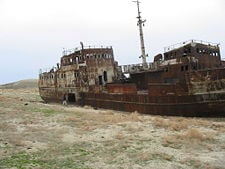
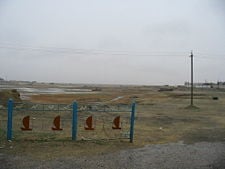
A channel was dug to connect the two separate bodies of water formed from the Aral Sea in the 1980s (the southern “Greater Sea” and the northern “Lesser Sea”), but that connection was gone by 1999 as the two seas continued to shrink. In 2003, the South Aral further divided into eastern and western basins; the evaporation of the North Aral has since been partially reversed.
Work is being done to restore in part the North Aral Sea. Irrigation works on the Syr Darya have been repaired and improved to increase its water flow, and in October 2003, the Kazakh government announced a plan to build a concrete dam (Dike Kokaral) separating the two halves of the Aral Sea. Work on this dam was completed in August 2005; since then the water level of the North Aral has risen, and its salinity has decreased. As of 2006, some recovery of sea level -from 98 feet to 125 feet - had been recorded, sooner than expected. [3]
Economically significant stocks of fish have returned, and observers who had written off the North Aral Sea as an environmental catastrophe were surprised by unexpected reports that in 2006 its returning waters were already partly reviving the fishing industry and producing catches for export as far as Ukraine. The restoration reportedly gave rise to long absent rain clouds and possible micro-climate changes, bringing tentative hope to an agricultural sector swallowed by a regional dustbowl, and some expansion of the shrunken sea. The World Bank reported "The sea, which had receded almost 100 km south of the port-city of Aralsk, is now a mere 25 km away." [4]
The South Aral Sea, which lies predominately in poorer Uzbekistan, was largely abandoned to its fate. Projects in the North Aral at first seemed to bring glimmers of hope to the South as well: "In addition to restoring water levels in the Northern Sea, a sluice in the dike is periodically opened, allowing excess water to flow into the largely dried-up Southern Aral Sea." [5] Discussions had been held on recreating a channel between the somewhat improved North and the desiccated South, [3] along with uncertain wetland restoration plans throughout the region, but political will is lacking. Uzbekistan shows no interest in abandoning the Amu Darya river as an abundant source of cotton irrigation, and instead is moving toward oil exploration in the drying South Aral seabed.[6]
Vast salt plains exposed with the shrinking of the Aral have produced dust storms, [7] and made regional winters colder and summers hotter. Attempts to mitigate these effects include planting vegetation in the newly exposed seabed. In the Northern Aral, recently higher sea levels have slightly moderated these effects in some areas, and the spring season now sees long-absent rainfall.
By summer 2003, the South Aral Sea was vanishing faster than predicted. In the deepest parts of the sea, the bottom waters were saltier than the top, and not mixing. Thus, only the top of the sea was heated in the summer, and it evaporated faster than would otherwise be expected. In 2003, the South Aral further divided into eastern and western basins.
In 2004, the Aral Sea's surface area was only 17,160 km2 (6,630 sq mi), 25 percent of its original size, and a nearly fivefold increase in salinity had killed most of its natural flora and fauna. By 2007, the sea's area had further shrunk to 10 percent of its original size. The decline of the North Aral has now been partially reversed following construction of a dam), but the remnants of the South Aral continue to disappear and its drastic shrinkage has created the Aralkum, a desert on the former lake bed.
The ecosystem of the Aral Sea and the river deltas feeding into it have been nearly destroyed, not least because of the much higher salinity. The receding sea has left huge plains covered with salt and toxic chemicals, which are picked up and carried away by the wind as toxic dust and spread to the surrounding area. The land around the Sea is heavily polluted and the people living in the area are suffering from a lack of fresh water and other health problems, including high rates of certain forms of cancer and lung diseases. Crops in the region are destroyed by salt which has been deposited onto the land. The town of Moynaq in Uzbekistan had a thriving harbor and fishing industry that employed approximately 60,000 people; now the town lies miles from the shore. Fishing boats lie scattered on the dry land that was once covered by water, many have been there for 20 years. The only significant fishing company left in the area has its fish shipped from the Baltic Sea, thousands of kilometers away.
The tragedy of Aral coast was portrayed in "Psy" ("Dogs"), a motion picture by Dmitriy Svetozarov (USSR, 1989). The film was shot on location in the actual ghost town, showing scenes of abandoned buildings and scattered vessels. More recently, in 1999, German filmmaker Joachim Tschirner has produced the documentary "Der Aralsee" for the channel Arte.
Possible solutions
Many different solutions to the variety of problems have been suggested over the years, ranging in feasibility and cost, including the following:
- Improving the quality of irrigation canals;
- Installing desalination plants;
- Charging farmers to use the water from the rivers;
- Using alternative cotton species that require less water;
- Using fewer chemicals on the cotton
- Redirecting water from the Volga, Ob and Irtysh rivers. This would restore the Aral Sea to its former size in 20-30 years at a cost of $30-50 billion.
In January 1994, the countries of Kazakhstan, Uzbekistan, Turkmenistan, Tajikistan and Kyrgyzstan signed a deal pledging one percent of their budgets to helping the sea recover. By 2006, the World Bank's restoration projects especially in the North Aral were giving rise to some unexpected, tentative relief in what had been an extremely pessimistic picture. [8]
By the end of the twentieth century, the area's population exhibited serious and severe health problems. The Karakalpaks, [9] in the southern portion of the region, were the hardest hit. They reported unusually high rates of such diseases as cancer of the throat, anemia and kidney disease. Infant mortality in the region was among the highest in the world. This is believed to have been caused by exposure to toxic dust contaminated with salt, fertilizer, and pesticides, carried across the region via dust storms stemming from exposed seabeds. [1]
Bioweapons facility on Vozrozhdenya Island
In 1948, a top-secret Soviet bioweapons laboratory was established on Vozrozhdenya Island in the middle of the Aral Sea (now disputed territory between Kazakhstan and Uzbekistan). The exact history, functions and current status of this facility have not yet been disclosed. What is known is that in addition to biological weapons testing during the Cold War - including on such agents as tularemia and the bubonic plague - hundreds of tons of live anthrax bacteria were buried on the island in the 1980s. [1]
The base was abandoned in 1992 following the disintegration of the Soviet Union. It soon after became the international center of environmental concern. With the shrinking of the sea, many of its islands have become peninsulas. By this time, Vozrozhdenya was only 6 miles (10 km) from the mainland. In 1999 still-living anthrax spores were discovered on the site, and scientists feared that when the island was no longer surrounded by water, animals could carry anthrax to populated areas.
In 2002, through a project organized by the United States and with Uzbeki assistance, the anthrax burial sites were decontaminated. [10]
Notes
- ↑ 1.0 1.1 1.2 1.3 1.4 1.5 1.6 Aral Sea Encyclopædia Britannica Online. Retrieved January 25, 2020.
- ↑ Tom Bissell, "Eternal Winter: Lessons of the Aral Sea Disaster." Harper's (April 2002): 41–56.
- ↑ 3.0 3.1 Ilan Greenberg, A vanished sea reclaims its form in Central Asia The New York Times, April 4, 2006. Retrieved January 25, 2020.
- ↑ Miraculous Catch in Kazakhstan's Northern Aral Sea The World Bank Group, June 2006. Retrieved January 25, 2020.
- ↑ Saving a Corner of the Aral Sea The World Bank Group, September 1, 2005. Retrieved January 25, 2020.
- ↑ Rustam Qobil, Waiting for the sea BBC News. Retrieved January 25, 2020.
- ↑ Aral Sea Dust Storm NASA Earth Observatory, March 26, 2010. Retrieved January 25, 2020.
- ↑ A Witch's Brew BBC News, July 27, 2006. Retrieved January 25, 2020.
- ↑ The Karakalpak People. Retrieved January 25, 2020.
- ↑ Zaria Gorvett, The deadly germ warfare island abandoned by the Soviets BBC, September 28, 2017. Retrieved January 25, 2020.
ReferencesISBN links support NWE through referral fees
- Bissell, Tom. "ETERNAL WINTER Lessons of the Aral Sea disaster." HARPERS 304 (1823) (2002): 41-57.
- Bissell, Tom. Chasing the sea: being a narrative of a journey through Uzbekistan, including descriptions of life therein, culminating with an arrival at the Aral Sea, the world's worst man-made ecological catastrophe, in one volume. New York: Vintage Books, 2004. ISBN 037572754X
- Ellis, William S. "The Aral: A Soviet Sea Lies Dying." National Geographic 177 (1990), 73–93.
- Ferguson, Robert W. The devil and the disappearing sea: a true story about the Aral Sea catastrophe. Vancouver, BC: Raincoast Books, 2003. ISBN 1551925990
- Kasperson, Jeanne X., Roger E. Kasperson, and B. L. Turner. Regions at risk: comparisons of threatened environments. UNU studies on critical environmental regions. Tokyo: United Nations University Press, 1995. ISBN 9280808486
- Micklin, Philip. "The Aral Sea Disaster." Annual Review of Earth and Planetary Sciences 35 (2007): 47.
External links
All links retrieved August 11, 2023.
- Aral catastrophe recorded in DNA
- Kazakhs 'to save north Aral Sea'
- Kazakhs get loan to save Aral Sea
- World of Change: Shrinking Aral Sea
- The Aral Sea Crisis
- History shows that parched Aral Sea can be restored
- Once Written Off for Dead, the Aral Sea Is Now Full of Life
- The country that brought a sea back to life
Credits
New World Encyclopedia writers and editors rewrote and completed the Wikipedia article in accordance with New World Encyclopedia standards. This article abides by terms of the Creative Commons CC-by-sa 3.0 License (CC-by-sa), which may be used and disseminated with proper attribution. Credit is due under the terms of this license that can reference both the New World Encyclopedia contributors and the selfless volunteer contributors of the Wikimedia Foundation. To cite this article click here for a list of acceptable citing formats.The history of earlier contributions by wikipedians is accessible to researchers here:
The history of this article since it was imported to New World Encyclopedia:
Note: Some restrictions may apply to use of individual images which are separately licensed.

